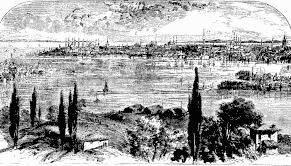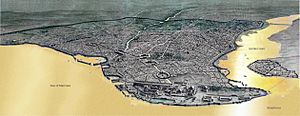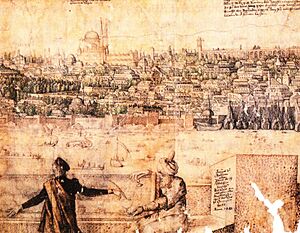History of Istanbul facts for kids

Istanbul is a very old city with a rich history. People have lived in this area for thousands of years. Archeologists found tools and signs of settlements from as far back as 6,000 BCE. This early settlement was important for spreading new farming ideas from the Near East to Europe.
Later, around 660 BCE, Greek settlers from a city called Megara built a city here. They named it Byzantium. This city was on the European side of the Bosporus, a narrow strait connecting two seas. Byzantium became part of the Roman Republic in 196 BCE. In 330 CE, it was renamed Constantinople and became the new capital of the Roman Empire.
During the time of Emperor Justinian I, Constantinople grew into one of the largest cities in the world. It had almost half a million people! It was the capital of the Byzantine Empire until 1453. That's when the Ottoman Turks conquered it. Constantinople then became the capital of the Ottoman Empire.
The city's population grew again under the Ottomans. By the 16th century, it had nearly 700,000 people. When the Republic of Turkey was founded in 1923, the capital moved from Constantinople to Ankara.
Contents
Ancient Beginnings
Humans have lived in the area of Istanbul for a very long time. The oldest known settlement was found in 2008. It dates back to 6700 BCE. This discovery happened during the building of a subway station and a tunnel on the European side.
On the Asian side, the oldest known settlement is called Fikirtepe. It's from the Copper Age, between 5500 and 3500 BCE. Near the modern area of Kadıköy, an old port settlement was found. It was used by the Phoenicians, who were famous traders.
The First Names: Lygos and Byzantium
The very first name for the city was Lygos. This name comes from historical writings by Pliny the Elder. It was probably founded by Thracians, an ancient people. Only a few old walls and foundations of Lygos remain today. They are near where the Topkapı Palace now stands.
Later, the city was called Byzantion, or Byzantium in Latin. This name might have come from the Thracian language. An old Greek story says a legendary king named Byzas led the settlers. He is said to have founded the city.
Greek settlers from Megara first tried to settle nearby in 685 BCE. Then, in 667 BCE, they founded Byzantium on the European side. This was the same spot where Lygos used to be. The main fortress, or Acropolis, of Byzantium was located where the Topkapı Palace is today.
In 196 CE, the city was badly damaged by the Roman Empire. This happened because Byzantium sided with an enemy of the Roman Emperor Septimius Severus. But Emperor Septimius Severus rebuilt Byzantium. For a short time, he even renamed it Augusta Antonina after his son.
Roman and Byzantine Eras
The location of Byzantium was very appealing to Constantine the Great. In 324 CE, he chose it as his new capital. This happened after he won a big battle nearby. Byzantium was then renamed Nova Roma (New Rome). Soon after, it became Constantinopolis, meaning "City of Constantine." It was officially made the new capital of the Roman Empire in 330 CE.
In 395 CE, the Roman Empire officially split into two parts. One part was the Western Roman Empire. The other was the Eastern Roman Empire, which we now call the Byzantine Empire. Constantinople became the capital of this Eastern Empire.
Constantinople was in a perfect spot. It was where Europe and Asia met. This made it very important for trade, culture, and defense. For most of the Byzantine period, it was the largest city in Europe. Emperor Constantine also made Christianity the main religion of the Roman Empire. This made Constantinople a major religious center.
The Flourishing Byzantine Empire
While the Western Roman Empire declined, the Eastern (Byzantine) Empire thrived. It became known for its Greek culture. After a split with Rome, it also became the center of Greek Orthodox Christianity. The city was filled with beautiful churches, like the Hagia Sophia. This church was once the largest cathedral in the world.
One of the most famous Byzantine emperors was Justinian (527-565 CE). He expanded the Byzantine Empire greatly. It stretched from Palestine to Spain. He also built the famous Hagia Sophia church. And he created an organized law system called the Codex.
From the 600s onwards, the Byzantine Empire faced many challenges. There were disagreements between the Byzantine and Roman churches. A big issue was the use of icons, which are images of holy Christian figures. Some Byzantines believed icons had holy power. Others, like Emperor Leo III, ordered them to be destroyed. This caused a lot of conflict. The Pope in Rome disagreed with destroying icons. This led to a major separation between the two churches.
Constantinople also had complex relationships with Kiev Rus', a powerful state in Europe. Many Kiev princes married daughters of Byzantine emperors. This connection helped spread Eastern Orthodoxy to Eastern Europe. However, they also fought wars, and Kiev princes sometimes attacked Constantinople.
Decline of Constantinople
Around 1204, Constantinople began to lose its power. During the Fourth Crusade, Western European armies attacked and captured Constantinople. They ransacked the city for its treasures. The Pope was upset, but the crusaders divided the empire among themselves. They never even made it to Jerusalem, which was their original goal.
This new "Latin Empire" in Constantinople lasted until 1261. Then, the Byzantines recaptured the city. But Constantinople never fully recovered its former glory. It became more like a collection of villages. By 1453, its population was much smaller than it had been.
Ottoman Empire Era
The city, known as Kostantiniyye or Istanbul, became the capital of the Ottoman Empire. This happened after the Ottomans conquered it in 1453. It remained the capital until the empire ended in 1922.
The Conquest of 1453
On May 29, 1453, Sultan Mehmed II, also known as "the Conqueror," entered Constantinople. This was after a 53-day siege. His powerful cannons had made huge holes in the city's walls. The city became the fourth and final capital of the Ottoman Empire.
Mehmed began the siege on April 6, 1453. He had special engineers build large cannons. He also had religious leaders encourage his soldiers. According to Muslim law, Mehmed offered the Byzantine emperor, Constantine XI Palaiologos, three chances to surrender. He promised safety for the city's people, their wealth, and their beliefs. But Constantine bravely refused.
After more than a month of fighting, Mehmed's advisors were losing hope. But Mehmed kept fighting. The night before the final attack, he studied past attempts to take the city. On the morning of May 29, 1453, the sultan ordered the call to prayer. This was a show of unity and strength to scare the Byzantine defenders.
The fighting lasted for 48 days. The city walls began to crumble. Constantine asked the Pope for help, and five ships with supplies arrived. Constantine also blocked the Golden Horn waterway to stop Ottoman ships. But Mehmed had his men build a path of oiled logs. They moved 80 ships overland into the Golden Horn, behind the enemy ships. The Ottoman ships then burned the Byzantine ones.
The Byzantine army was still holding on. So, the sultan used a secret weapon: a huge mobile tower. This tower could hold many soldiers. They could fight at the same level as the city walls. The first Ottoman soldiers who entered were killed. But the sultan encouraged his troops. Soon, the Muslims broke through the wall in two places and entered the city. Emperor Constantine fought bravely but was killed.
Constantinople was now under Ottoman rule. Mehmed entered through what is now the Topkapi Gate. He rode to the Hagia Sophia and ordered it to be turned into a mosque. He had a Muslim prayer chanted there. This showed that Turkish rule was now firm in Constantinople.
Mehmed allowed the city to be plundered for three days. After that, his main goal was to rebuild and repopulate the city. He immediately started projects to repair the walls and build a new palace. He ordered people from all over his empire—Muslims, Christians, and Jews—to move to Constantinople. He wanted 5,000 families to move there by September.
Imperial Capital of the Ottomans
By 1459, Sultan Mehmed worked hard to make Constantinople prosperous again. He created religious foundations in different parts of the city. These included colleges, schools, public kitchens, and mosques. He also allowed Greeks who had left the city to return. These actions helped the city become a thriving capital once more.
Suleiman the Magnificent ruled the Ottoman Empire from 1520 to 1566. This was a time of great art and architecture. The famous architect Mimar Sinan designed many mosques and grand buildings. Ottoman arts like ceramics and calligraphy also flourished. Many religious centers, called tekkes, still exist today. Some are mosques, and others are museums.

Before the Ottoman conquest, Constantinople's population had fallen. Mehmed II wanted to create a new, diverse city. Most of the remaining Byzantine people, about 30,000, were moved out. Mehmed then encouraged people from all his lands to move to Constantinople. He even forced some families to move there. This helped the city become populated again.
Mehmed personally cared about his new capital. He ordered the building of a large mosque and college on the old burial grounds of Byzantine emperors. The great Christian city slowly became a great Muslim city. But it was not entirely Muslim. Slavs, Greeks, Jews, and Armenians were allowed to settle there. Their skills were needed. The city became known as alem penah, meaning "refuge of the universe."
In 1477, a census showed that Muslims, Greeks, Jews, and Christians from Crimea lived in the city. There were also Gypsies. Mehmed also brought back the center of the Orthodox Christian Church to Constantinople.
There was also an Italian community near the Galata Tower. They were allowed to keep some self-government. For many years, they provided interpreters and diplomats for the Ottoman court. After the Ottomans conquered Egypt in 1517, Constantinople gained even more importance for Muslims. Mosques built by Sultan Suleiman I and others gave the city its unique look.
Modern Changes
As years passed, Istanbul's population grew. It went from about 80,000 after Mehmed's death to 400,000 by 1800. As the capital of a large empire, it also became an important place for international relations. Many foreign embassies were located there.
From the 1870s, the city became more modern. Bridges were built, and a proper water system was created. Electric lights, trams, and telephones were introduced.
Republic of Turkey Era
In 1915, during World War I, the Allies tried to capture Constantinople. But the Ottoman Army defended the city successfully. After World War I, Allied forces occupied Constantinople from 1918 to 1923.
When the Republic of Turkey was founded in 1923, its capital moved from Constantinople to Ankara. As a result, Istanbul's population dropped sharply. But it grew steadily again in the later 20th century. By 2000, the city's population was over 10 million.
The city's current name, Istanbul, comes from a Greek phrase meaning "to the city." This name was commonly used by local people for a long time. The international name Constantinople was still used until Turkey adopted the Latin alphabet in 1928. Then, Turkey asked other countries to use "Istanbul."
In the early years of the Republic, Istanbul was not as important as Ankara. But from the late 1940s, Istanbul changed a lot. New public squares, boulevards, and avenues were built. Sometimes, this meant tearing down old buildings.
In September 1955, many Greek businesses were destroyed during events known as the Istanbul pogrom. This led to many Greeks leaving the city. Other groups like Jews and Armenians were also affected.
From the 1970s, Istanbul's population grew very fast. Many people from Anatolia moved to the city for jobs in new factories. This rapid growth led to a huge demand for housing. Many small villages and forests around the city became part of Istanbul.
In March 1995, there were incidents in the Gazi Quarter where people were killed and injured. These events started with an attack on coffee shops. Protests followed, and police responded.
Recep Tayyip Erdoğan, who later became Prime Minister of Turkey and President of Turkey, was the mayor of Istanbul from 1994 to 1998.
In 2013, Taksim Square was the center of the Gezi Park protests. People protested about freedom of the press, expression, and assembly. They also protested about the government's actions regarding Turkey's secularism.
In July 2016, there was an attempt to take over the government in Turkey. Some rogue military units were involved. They surrendered on the Bosphorus Bridge in Istanbul after a few hours.
In June 2019, the main opposition party won the Istanbul mayoral election rerun. Ekrem İmamoğlu became the new Mayor of Istanbul.
Istanbul's new airport opened in October 2018. It started passenger services in April 2019. This new Istanbul Airport is one of the biggest airports in the world. It replaced the old Atatürk Airport.
In November 2022, a bombing on İstiklal Avenue killed six people and injured many. Turkish authorities blamed certain groups, but one group denied involvement.
As of August 2023, Istanbul hosts over 530,000 refugees from the Syrian civil war. This is the highest number of Syrian refugees in any Turkish city.
|
See also
- Timeline of Istanbul








